July 14, 2008 |
BITE: My Journal
Paul Bocuse: The Lion in Winter
 |
|
Paul Bocuse strikes a pose on his Rue des Grand Chefs in the courtyard. Photo:Steven Richter
|
Given the speed and efficiency of France’s TGV train, getting to Lyon for lunch with Paul Bocuse is a cinch compared to inching your way to Easthampton in time for dinner Friday evening. The Road Food Warrior and I have been invited to a lunch arranged for Jean Luc Colombo – his big supple Cornas is the new Rhone wine sensation. We are joining Jean Luc, his wife and their pals at the three star house of Paul Bocuse, Collonges au Mont d’Or, north of Lyon. I can’t recall how long it’s been since I made this pilgrimage. Decades, for sure. In the seventies and early eighties, when most chefs could be found in their kitchens, we early obsessed innocents abroad often drove directly to Mionnay to be overindulged by Alain Chapel, with a stop at Mère Blanc or Lameloise, then headed for Troisgros. Though I always admired the bravura of Bocuse as the leader of a chef’s rebellion in the early seventies – “Why should a chef die on his feet in the kitchen?” was his credo - I wanted to see the proud eagle-beaked master in the dining room and felt insulted when he was off to Japan.
“Who cooks when you are away?” he was famously asked.
“The same person who cooks when I am here,” he replied. That’s a line I hear from our own wander-lusting chefs even now. Then curious to see what the house of Bocuse was cooking when the rest were going gaga over “nouvelle cuisine,” I dropped in during one of the many tasting binges New York magazine graciously underwrote for the updating of my critical mouth. Neither Bocuse nor his right hand chef de cuisine Roger Jaloux was in the kitchen. I fumed a little and then had one of the best meals I’d ever eaten there.
Well, with the revolution in dining at home demanding constant pots and pans, and the galloping demands of the Euro, I no longer have a willing sponsor for those annual excursions. I’ve dipped only occasionally and grudgingly with my own feeble dollars into a world where dinner, a bed and breakfast for a night might run $2000 a couple because I still believe a critic ought to know what’s happening in France. Mostly I’ve focused on the best food in Paris at an accessible price and what’s worth a splurge.
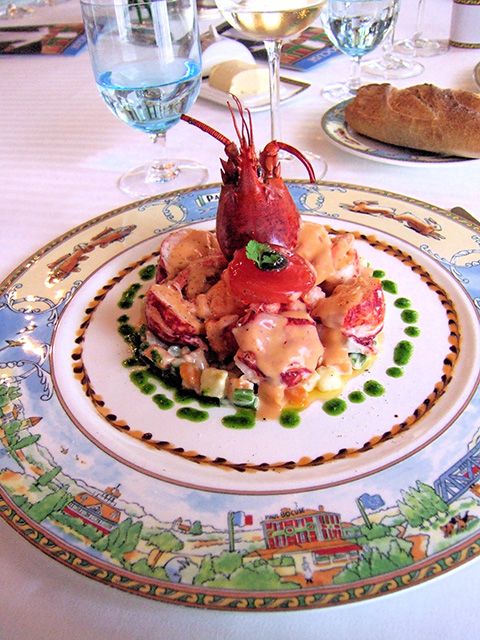 |
True to tradition, lobster salade has small vegetable dice and a familiar sauce. Photo:Steven Richter
|
The invitation to lunch, instigated by the irresistibly charming publicist and fantasy-enabler, Yanou Collart, is irresistible. That’s why my guy and I are committing almost $650 to get to Collonges – for the speedy two-hour train ride and connecting taxis to the small town Bocuse taught us to spell. I longed for this connection as a link to the past – my own forty years as a restaurant critic - and perhaps even as a goodbye. Bocuse’s family had said he wasn’t well enough to fly when we invited him to be honored at Crème de la Crème, a celebration of France’s legendary chefs for Citymeals in the garden at Rockefeller Center in June. His son Jerôme came from Disney World to cook a dish of his father’s.
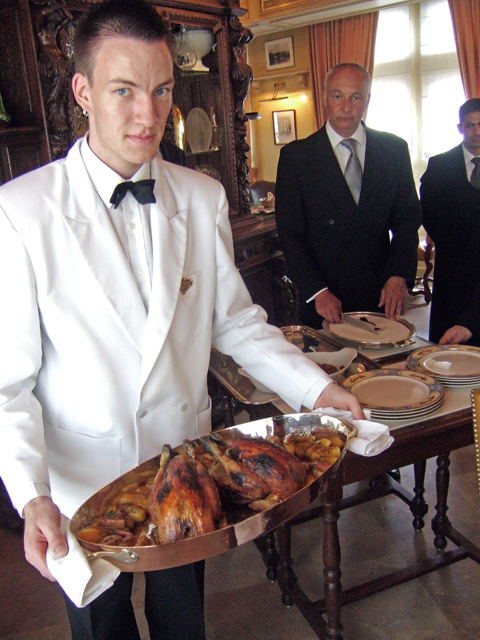 |
|
I like to think of these truffled birds as the bruised chickens of Bresse. Photo: Steven Richter.
|
Once the taxi from Lyon has delivered us, we’re greeted by an assistant who leads us into the courtyard where Paul sits surrounded by a series of painted murals, his glorious “Rue des Grand Chefs.” He stands for a hug, thick in his whites and long apron…and slow. The son, grandson and great grandson in a line of cooks dating to the 17th century, he is in his 42nd year of three Michelin stars. And it looks like he has never stopped embellishing the once simple country house where he started cooking with his father. There are brass plaques underfoot commemorating friends who have died as you walk toward the door, articles and accolades everywhere. The fanciful red and green paint job gives the expanded building an Alpine look, a hint of Disneyland. You can laugh at the paintings on the terrace, but they are fabulous. In the first, we see Carème with his patron Napoleon, Empress Josephine at his side, palming an American Express card. Paul points it out in case you missed that card. “Napoleon is broke and he pays with the credit card.” I remark on the portrait of Eugénie Brazier with her signature chicken, Mère Brazier, whose food I never tasted. I remember the bitter frustration of getting lost on an endlessly winding dark road – inciting a marital crisis over my navigation woes – only to find her place closed for the night. Paul’s father sent him to work for her at Col de la Luère where, Rudy Chelminski writes, “he woke at 5 a.m. to chop wood for the stove, milked the cow, tended the garden, did her laundry and starched and ironed the tablecloths before he got a chance to cook.” There is another woman in the panorama. “That is the mère who taught Mère Brazier.”
Shall he stand in front of a family portrait – three generations of Bocuses? I ask Steven. No, it is hidden in shadow. So he poses in front of his early mentor – Fernand Point and wife Mady with Pierre Troisgros in their kitchen. All the stars of the seventies revolution are here and in a panel all their own, a slender James Beard and Julia dynamically prepping for the television camera. His expression is stern but he is clearly pleased with his vision of history and his plans for this day.
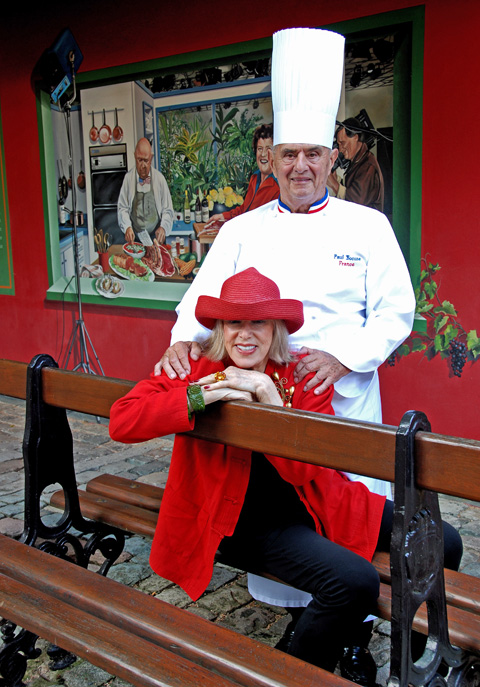 |
|
How cool Paul is to honor Beard and Julia in his cavalcade of culinary stars. Photo: Steven Richter
|
“The chickens are on the spit,” Paul tells me, pointing to the birds visible through the kitchen window.
“It is just like the day our group arrived on that Moët et Chandon junket,” I remind him. “When you fed us caviar, foie gras and jambon in your catering hall while the calliope played the Stars and Stripes.” We all thought that was lunch. But then we realized that was merely the aperitif as Bocuse announced a sit down lunch in the dining room – that iconic chicken and much more. And as we boarded our small jet for Paris, he insisted we must take a groaning picnic basket to eat on the plane, “Just in case of hunger.” He was determined we’d have no appetite left for Michel Guérard’s dinner at Le Pot au Feu. (The plot failed, proving once again my theory: the more you eat, the hungrier you are. The same rule that applies to sex.)
Our wine maker host and his guests arrive. Bocuse calls his assistant to bring a camera, puts himself in the middle, and insists Steven get into the picture too. “Champagne,” he cries. A table appears. Glasses are poured…a waiter passes warm gougères lush with cheese. I propose a toast to Paul, “a pain grillée” I say, French for toasted bread, the only double entendre I have in my limited French. We drink to the man who changed the world of gastronomy…who freed chefs from anonymity in their kitchens…whose élan and cuisinary hijinks inspired young Americans to think it could be fun to be a chef, to own a restaurant.
There
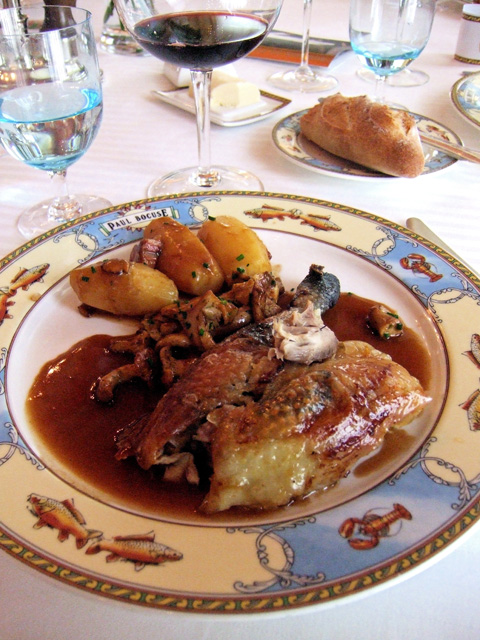 |
Teeny Barbie doll portions don't appeal to the chef's values. Photo: Steven Richter
|
is only one other table occupied in the big old-fashioned front room with its massive armoire and his name everywhere, on the porcelain and goblets, the initials PB on the backs of the silver, on the folded card a captain passes out now, showing the chef in his towering toque, arms wide open in welcome. Printed inside, the portrait of us taken minutes ago, with all our names in the order we are standing and opposite, the menu of our lunch. A stunning trick.
“This is gold leaf,” a guest comments.
“Yes, that means it is more expensive,” Bocuse responds. Everyone smiles.
We are surrounded now by a lineup of minions in black and white, dispensing a smartly vivid tomato soup in a miniature of the lion-head bowl the chef made famous when he used it for his consommé with foie gras under a pastry dome at the Elysées Palace in 1975. “Tomatoes from the garden,” he responds when I ask where these early tomatoes get their pow.
A gorgeous mound of exquisitely cooked Breton lobster “a là parisienne” with cubed vegetables, and what tastes like a Louis sauce fills the rococo plate. Then the birds of Bresse arrive to be carved, crackling skin “bruised” with black discs of truffle underneath.
“Will I have the breast or the leg?” the waiter asks.
I get the dark meat I prefer, with the slight chewiness that makes most other chickens seem factory-made. We are eating his $265 Menu Bourgeoise. How marvelous to eat real food, too much on every plate, to escape modern tics and fetishes, the meaningless slashes of sauce, the teasing buttons of meat in three guises, possibly one you hunger for and two also-rans, belligerent combinations that probably came to the egomaniacal chef in a nightmare. And, certainement, molecular notions do not disturb tradition in Collonges.
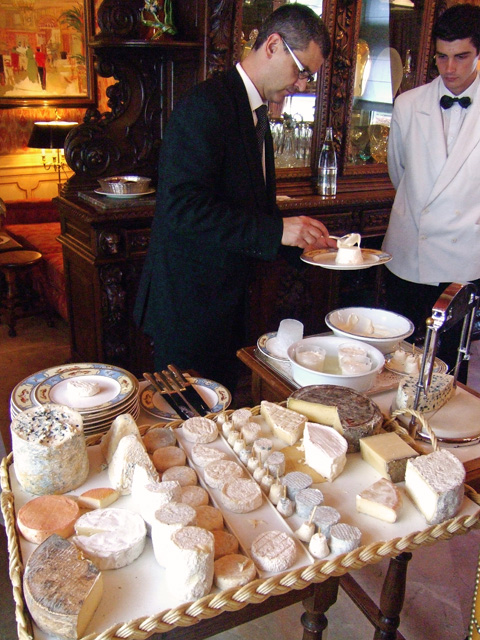 |
|
Of course it's no surprise that the cheese cart is dazzling. Photo: Steven Richter
|
It goes without saying that the cheese cart is dazzling. Granted we have our own cheese devotions at home now, but still it is thrilling to have a creamy San Marcellin and a luscious Saint Nectaire not far from the cow itself. If it were a quiz show and they asked, “What will M. Bocuse offer for dessert?” you should have no problem guessing. Red fruit, of course. At the moment when berries and currants are glorious, the dessert plate is a Valentine in red and green…wild strawberries, sublime raspberries, a heart-shaped sandwich cookie and possibly the best pistachio ice cream I can remember.
Of course there are chocolates on the silver tiers of the mignardises display…and macaroons, alas, not exactly fresh. And a rush of caffeine to see you off to the Lyon train station chaos. Bocuse and I hug goodbye – a real hug, a real kiss – I feel his cheek not the air.
Neither of us says anything, but I know it is goodbye.
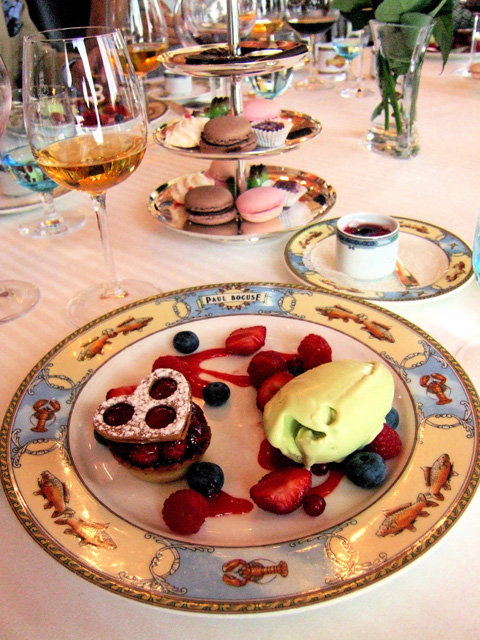 |
|
Summer means dessert will be exquisitely ripe red fruit. Photo: Steven Richter
|
At dinner a night later, I am telling my long time French journalist pal about the evening. How fabulous the food was. How sweet and funny the paintings. How moving it was to evoke the memories of so many adventures dreamed up by Bocuse or by his gourmand sidekick, Yanou. Remembering his “Dinner of the Century” at the Four Seasons in New York. A historic “Dinner for Women” that followed. Veal rumps seized in customs. Weekends of cutting up to promote the Rhone Valley. Paul’s unfailing quips and quotability, more often than not, insulting to women.
As Rudy Chelminski notes in his homage on the back of the menu, the Bocuse legacy extends beyond the boyhood home-turned-monument, his four Lyon brasseries and a fifth venture, Argenson, in front of the football stadium, to a prestigious cooking school, the Paul Bocuse Institute in Écully, the annual competition of professionals he founded, le Bocuse d’Or, and the French cooking courses he organized and coordinated over three decades in Osaka.
“No one in France talks of Bocuse anymore,” my dinner companion observes. “No one speaks of his food… You never hear his name.” He sips his wine. He looks at me a bit defensively. He dares to speak the unspoken. “I suppose there will be a state funeral for him when he dies.”
Menu Classique $185. Menu Bougeois $265. Menu Grand Tradition Classique $320. Children under 12 $32. 011 33 04 72 42 90 90 www.bocuse.com
***